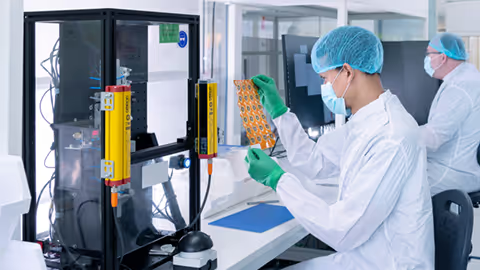The tried and tested status quo
Until recently, the standard way to monitor glucose levels was using a finger stick test, where the patient uses a small, portable device to take a tiny blood sample and measure it. If necessary, they can then have a snack or take insulin to keep their glucose at the right level.
Ideally, patients would test themselves around four times a day, sometimes more, and respond appropriately, but this is a huge burden. It is estimated that diabetics make 180 more health-related decisions every day than non-diabetics. It is no wonder that this can be overwhelming, and sometimes glucose monitoring can get neglected. That’s why ‘closed loop’ systems are being developed, where monitoring and treatment is moving toward being fully automated, leaving patients free to get on with their lives.
A new dawn?
The most exciting tool that’s emerged in this space over the past 10 years is continuous glucose monitoring (CGM), where the patient wears a sensor. A CGM is a small, circular patch device worn on the arm or abdomen, with a tiny sensor piercing the skin surface to sit in its subcutaneous layer. It takes a measurement of blood glucose every five minutes, does some analytics, and relays the results to the patient via a phone app. If immediate intervention is required, an alarm goes off to alert the patient, even at night.
Unlike finger stick tests, which test capillary blood outside of the body, CGMs need to achieve this measurement within the interstitial fluid in this subcutaneous region of the body. Originally, CGMs were far less accurate but were able to give a much better overall picture of a patient’s comparative variations in blood glucose throughout the day. The technology continues to improve, however, enabling CGMs to get close to the accuracy of finger sticks, but with all the advantages of being continuous and automated.
Most currently CGMs can only be worn for two weeks before having to be replaced, and many patients would prefer not to have to wear a visible sensor at all. One next step, then, could be fully implantable sensors. The most advanced version of this type of technology that is currently on the market can be used for 180 days, though patients still have to wear an external transmitter. In the near future, it is hoped that it will be possible to insert a device that the patient can forget about for years at a time, while it continues to provide accurate blood glucose readings that are not distorted by external environmental factors.
The near horizon: a hybrid closed loop?
Automatic monitoring of glucose levels only gets us halfway to a closed-loop system. What about automating the required interventions, such as administering insulin? The technology already exists to deliver regular basal doses of insulin through a wearable pump, but it requires patient intervention to deliver additional boluses taken at meal times to manage blood glucose levels after eating. Some patients are already ‘hacking’ their devices to close this loop by using custom software to connect the sensor data from a CGM to their insulin pump, so it delivers exactly what is needed rather than the pre-determined basal dose.
This kind of technology is not yet widely available, however, because of the obvious risks involved. While taking patients out of the loop frees up their time, it also removes a key safeguard. Patients are able to make judgments based on experience; if a reading is way off, for example, this prevents them from administering an obviously incorrect dose of insulin. Without robust safeguards in place, a fully closed-loop system could deliver incorrect doses automatically.
For that reason, manufacturers are understandably proceeding with caution. One possibility is that as we start to measure additional complementary analytes – as well as things like temperature and blood pressure – that this will enable us to spot and correct for any measurement errors, and have much higher confidence in developing fully personalised treatment regimes. Machine learning might then begin to replicate the patient’s understanding of their own condition, re-introducing this crucial safeguard and allowing much safer closed-loop systems.
Another possibility is sensing and administering glucagon, which causes blood glucose to increase and can counter the effects of insulin. At the moment administering insulin is very much a one-way street; once you have delivered it you can’t take it back, so usually this is done cautiously. If you give yourself the ability to counteract the effects of insulin, you can react to blood glucose changes much faster without the concern that you might overshoot your target.
The future is wide open
When it comes to diabetes, there may be longer-term solutions that go beyond glucose monitoring. For example, glucose reactive insulin is being engineered to respond to the glucose in the patient's blood in such a way that it can self-regulate, meaning that accurate dosing is not required and overdosing is impossible. Further down the line, pancreatic beta cells could be engineered and transplanted into patients to enable them to produce their own insulin.
In the meantime, the progress being made in real-time blood glucose monitoring is not only revolutionising the treatment of diabetes, but also providing valuable experience and insights that will be applicable to other real-time analyte sensing contexts, such as lactates, ketones, or potassium.
My colleagues at TTP and I are very aware that progress in medical technology is not unilinear. We are constantly surveying the horizon for new ways of solving the problems that occupy us. When it comes to sensing, there are pros and cons to non-invasive, wearable, and implantable solutions, and the right implementation will depend on the user, the use case, and a whole range of human factors considerations.
There isn’t a one-size-fits-all solution to many of these challenges. And looking at the big picture, we do well to remember that in much of the world, diabetic patients do not even have access to something as basic as a finger stick test, so developing technologies that are able to hit the right cost-point and make a real difference to how people manage their conditions is hugely important.
That’s why we are so excited about working with innovators. The key is that new solutions are easy to use, robust and reliable – and of course both scalable and commercially viable – even if they turn out to be very different from the solutions we are expecting. In the case of diabetes, 415 million people stand to benefit from our effective collaboration. That’s an excellent motivation to keep exploring all the options and make the most of each emerging possibility.
Emerging biosensor technologies are enabling the measurement and analysis of valuable trace markers, leading to improved clinical outcomes.
About TTP’s Biosensing Consulting Team
Specialising in the development of wearable and implantable biosensors, TTP’s Biosensor product design and development consultants deploy multidisciplinary teams, combining expert capabilities to deliver tailored solutions that meet the most demanding project requirements.
Whether navigating uncharted territories, supporting your next innovation or accelerating time to market, we solve complex challenges with engineering and scientific rigour, finding and retiring risks early to deliver high-impact, human-centred results. When your internal bandwidth is constrained, TTP is ready to deliver.
Read more about how we are accelerating continuous glucose monitoring design and development.
TTP's Biosensing team is part of our broader Medical Device Consulting business unit, consisting of 300+ engineers, scientists, and human factors specialists. For nearly four decades we've partnered with clients to develop impactful solutions, helping them achieve commercial success. See our approach to medical device design and development.










